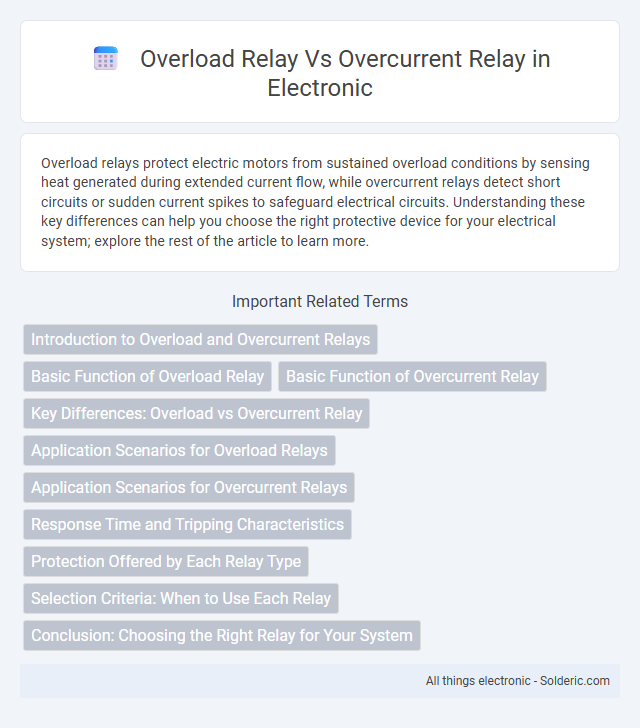Overload relays protect electric motors from sustained overload conditions by sensing heat generated during extended current flow, while overcurrent relays detect short circuits or sudden current spikes to safeguard electrical circuits. Understanding these key differences can help you choose the right protective device for your electrical system; explore the rest of the article to learn more.
Comparison Table
| Feature | Overload Relay | Overcurrent Relay |
|---|---|---|
| Purpose | Protects motors from prolonged overload conditions | Protects circuits from excessive current including short circuits and overloads |
| Type of Protection | Thermal or Magnetic-Thermal | Instantaneous or Time-Delayed Magnetic |
| Operation | Trip on sustained overload current above rated motor current | Trip on current exceeding set threshold immediately or after delay |
| Application | Motor protection mainly in motor control circuits | General circuit and feeder protection |
| Current Range | Low to medium currents matching motor ratings | Wide current range including very high fault currents |
| Response Time | Delayed response based on thermal characteristics | Fast or instantaneous response |
| Reset | Manual or automatic reset depending on type | Usually manual reset |
Introduction to Overload and Overcurrent Relays
Overload relays protect motors by detecting excessive current caused by prolonged overload conditions, preventing overheating and damage. Overcurrent relays respond to current surges exceeding set thresholds rapidly, safeguarding electrical systems from short circuits and faults. Your choice between these relays depends on the specific protection needs of your electrical equipment and system configuration.
Basic Function of Overload Relay
Overload relays protect electrical motors by detecting excessive current caused by prolonged overload conditions, preventing overheating and potential damage. They operate based on the thermal or magnetic properties that trigger a trip when current exceeds preset limits over time. Your motor's safety relies on this functionality, distinguishing overload relays from overcurrent relays which respond to instantaneous current surges or faults.
Basic Function of Overcurrent Relay
Overcurrent relays detect excessive current flow caused by short circuits or ground faults, protecting electrical systems from damage by interrupting the circuit quickly. Unlike overload relays that primarily address prolonged current above normal levels, overcurrent relays respond to instantaneous surges to ensure safety and system stability. You rely on overcurrent relays to safeguard equipment by promptly isolating fault conditions before serious harm occurs.
Key Differences: Overload vs Overcurrent Relay
Overload relays are designed specifically to protect motors from prolonged overcurrent conditions caused by mechanical overload or stalled rotor situations, typically responding to current levels that are slightly above the motor's rated current over an extended period. In contrast, overcurrent relays detect any current exceeding a preset threshold, whether short circuits, ground faults, or overloads, and operate almost instantaneously to isolate the fault. The key difference lies in their protection scope and response time: overload relays focus on thermal protection with time-delay characteristics, whereas overcurrent relays provide fast-acting protection against sudden, potentially damaging current surges.
Application Scenarios for Overload Relays
Overload relays are primarily designed to protect motors from overheating caused by prolonged excessive current, making them ideal for applications in motor control circuits, industrial machinery, and HVAC systems where motor longevity is critical. These relays detect sustained overcurrent conditions rather than short circuits, preventing damage due to thermal stress in motors during startup or stalled operations. Your equipment benefits most from overload relays when consistent monitoring of current levels ensures safe operation in environments prone to motor overload conditions.
Application Scenarios for Overcurrent Relays
Overcurrent relays are primarily used in power systems to detect and protect electrical circuits from excessive current caused by faults like short circuits or ground faults. They function efficiently in transmission and distribution networks, safeguarding transformers, generators, and feeders by isolating faulty sections to maintain system stability. Your electrical protection strategy benefits from overcurrent relays due to their capability to respond to various overcurrent conditions and provide selective tripping.
Response Time and Tripping Characteristics
Overload relays respond more slowly as they protect motors from prolonged overheating by monitoring current over time, typically tripping based on thermal characteristics to prevent insulation damage. Overcurrent relays, designed for instantaneous or time-delayed tripping, detect fault currents and operate faster to isolate short circuits and severe overloads, with adjustable settings for precise protection. The distinction in response time and tripping ensures overload relays safeguard motor health while overcurrent relays provide rapid fault clearance to protect electrical systems.
Protection Offered by Each Relay Type
Overload relays protect electric motors from prolonged overcurrent conditions by monitoring current flow and tripping the circuit when currents exceed rated levels for a specified time, preventing motor burnouts. Overcurrent relays offer broader protection against short circuits and high current faults in electrical systems, detecting instantaneous surges that could damage equipment or cause safety hazards. Understanding the differences in protection offered by overload relays and overcurrent relays helps you select the appropriate relay to safeguard your electrical devices effectively.
Selection Criteria: When to Use Each Relay
Overload relays are selected for protecting motors from prolonged excessive current caused by mechanical overload or stalled conditions, making them ideal for motor control circuits requiring thermal protection. Overcurrent relays are chosen for broader applications, such as protecting electrical systems from transient high currents, including short circuits and fault conditions, where fast response and coordination with other protective devices are crucial. Selection criteria depend on current type, duration of fault, and system configuration, with overload relays for thermal damage prevention and overcurrent relays for rapid fault isolation.
Conclusion: Choosing the Right Relay for Your System
Selecting the right relay for your system depends on the specific protection needs and operating conditions. Overload relays provide protection against prolonged current exceeding motor ratings, ideal for preventing motor burnout, while overcurrent relays protect against short circuits and sudden current spikes, ensuring overall system safety. Understanding the distinct functions and application scenarios of overload and overcurrent relays will help you optimize system reliability and safety effectively.
Overload Relay vs Overcurrent Relay Infographic

 solderic.com
solderic.com